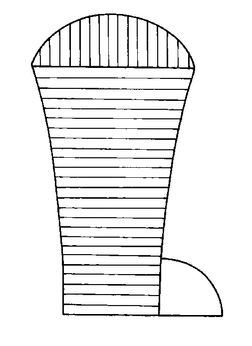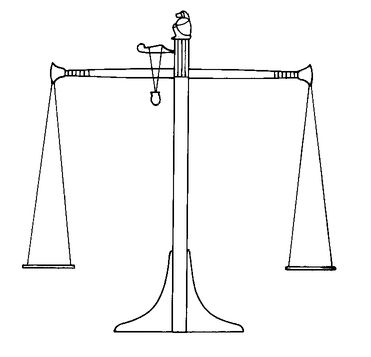Read Think Like an Egyptian Online
Authors: Barry Kemp
Think Like an Egyptian (35 page)
The desert regions accessible from the Nile Valley, including the southern Sinai peninsula, contain deposits of metals, including copper, iron, and tin on a limited scale. The advantage of copper over iron is that it can be smelted out from its ore and then subsequently cast or beaten into manufactured objects with the use of relatively low temperatures. The hieroglyph depicts a simple pottery crucible in which metal ore was smelted. When written out fully, the granular hieroglyph is added, thus
 (see no. 3, “Grain”).
(see no. 3, “Grain”).
 (see no. 3, “Grain”).
(see no. 3, “Grain”).The addition of tin (the essential ingredient to convert copper to bronze) improves workability and increases the hardness of the product and the potential sharpness of edges. The replacement of copper by bronze proceeded quite slowly in Egypt but was largely complete by the New Kingdom. Modern methods of analysis when applied to ancient Egyptian metalwork suggest that Egyptian metal smiths had a sensitive understanding of their craft and controlled mixtures and procedures to produce a particular degree of hardness.
Copper and bronze found widespread use, in axes (as tools and weapons), needles, and chisels, as nails for wooden joinery, as scale-plates to make armor in the New Kingdom, as sheeting to cover statues, as domestic utensils, and to fashion into vessels that would hold water much better than pottery versions. In any form, even scrap pieces of copper and bronze held their value because they were a basic unit of exchange, weighed out in deben units. People were careful not to discard metal objects.

89.
POTTER’S KILN
It is disconcerting to walk across an ancient Egyptian town site, for all the time one is crunching ancient pieces of pottery underfoot, it is that plentiful. Egypt has abundant clays, from the Nile mud and from deposits in the desert. In the prehistoric periods pottery was sufficiently valued for broken vessels to be repaired, by drilling holes on either side of the break and binding the shards together. This was also the time when potters added painted decoration to their products. Both traditions died as society became richer during the 1st Dynasty. Thereafter, pottery was a cheap utilitarian product that could be easily discarded.
Pottery bowls and cups were used in households as tableware, although we have to assume that richer people also used vessels of metal, including some made of gold in the case of royalty. Pottery vessels with deep bodies and narrower necks were for transporting and storing a wide range of commodities, from water, wine, and honey, to incense, joints of meat, and cooking oil. Contents were sometimes written on the outside. In the New Kingdom the Egyptians adopted as the standard storage jar a tall two-handled vessel with a pointed base, copied from pottery developed in Palestine and Syria. It was widely transported around the eastern Mediterranean in little trading ships. Two wrecks of these ships have been discovered off the southern coast of Turkey with their cargoes lying on the seabed, numerous two-handled storage jars among them.
Egyptian pottery was made with skill even though the technology was simple. The potter’s wheel was used widely only in the late Old Kingdom, and even then remained a low turntable rotated by hand either by the potter or an assistant squatting on the ground. The hieroglyph that writes the word “kiln” depicts a simple construction: a tall brick cylinder about two meters in diameter above a circular pit that held the fire. A pierced floor of clay bars kept the stacked vessels separate from the fire beneath, which drew its air supply from a single hole at ground level. A good part of a household’s pottery needs were met locally, with only the more robust storage vessels purchased from distant, specialized producers.

90.
BALANCE
Many ancient pictures exist of the balances used to weigh items. They were made with an upright post supporting a horizontal beam, pivoted in the middle. From each end hung a shallow metal pan. A plumb-bob separately suspended in the middle helped to ensure that the balance was set upright. To encourage a sense of responsibility a baboon figure, representing the god Thoth, was placed on top. The outline of a balance provides the hieroglyphic determinative to the word


 m
m
 ૩t (mekhat),
૩t (mekhat),
“balance,” itself derived from the word
 ૩
૩
 (khai),
(khai),
“to measure.” In everyday transactions a smaller version was used that dispensed with the central post, the owner simply holding the horizontal beam suspended by a short piece of cord.


 m
m ૩t (mekhat),
૩t (mekhat),“balance,” itself derived from the word
 ૩
૩ (khai),
(khai),“to measure.” In everyday transactions a smaller version was used that dispensed with the central post, the owner simply holding the horizontal beam suspended by a short piece of cord.
The balance measured the weight of items against a system of weights based on the deben, which we know is approximately 91 grams, made up of ten smaller units called “kité.” The reference weights were stones shaped like little cakes, or sometimes carved in more fanciful shapes such as a recumbent ox. The responsibility for ensuring that all deben weights were uniform probably lay with temple staff.
Only certain commodities are suited to weighing; in ancient Egypt most obviously the metals copper, bronze, silver, and gold. Evidence from the later New Kingdom points to an informal conversion ratio of silver to bronze of 1:100, and of gold to silver of 2:1. No one weighed grain; it was far too bulky. Instead, grain was reckoned by volume, using a scoop of standard size, the “hekat,” and its larger multiple of 16, the “khar,” equivalent to 76.88 litres. From constant practice the Egyptians were able to express the value of a particular measure of, say, grain as being worth so many deben of bronze. Figures from the later New Kingdom show that one khar of wheat or barley was worth two deben of bronze.
Other books
Home Front Girls by Rosie Goodwin
A Stitch on Time 5 by Yolanda Sfetsos
Snowfall and Secrets (The Omega Mu Alpha Brothers Book 1) by Kierra Quinn
Mega #02 Baja Blood by Jake Bible
EMPTY SECRETS (A Back Down Devil MC Novella) by Casey, London, James, Karolyn
Under Her Skin by Frost, Jeaniene, Brook, Meljean, Andrews, Ilona
The Old House (Haunted Series Book 16) by Alexie Aaron
The Judgment of Caesar by Steven Saylor
A Measure of Discipline by Diane Adams
The Sorcerer of the Wildeeps by Kai Ashante Wilson
